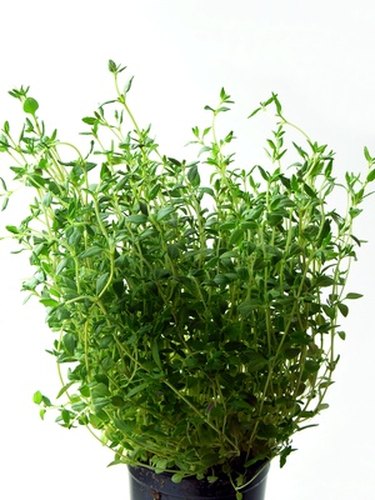Things You'll Need
Thyme
Ruler

Thyme is related to the mint family of herbs. It is a favorite among herb gardeners for its fragrance, flavor and ornamental value. There are literally hundreds of varieties grouped into three major types: clumping, low creeping, and tall upright. Thyme is highly aromatic, with each type having a slightly different scent and bearing different shapes and colors of flowers and leaves.
Step 1
Notice the height of the plant. The low-creeping types of thyme grow 4 to 6 inches high. They are often used as border plants or along stone walls. Common Thyme (Thymus vulgaris), a French variety, makes an excellent plant in rock gardens and is useful as a small hedge. It grows upright from 12 to 16 inches high and has medium-sized leaves that curl under. It also has a gentle aroma. In the spring it produces small lilac-colored flowers.
Video of the Day
Step 2
Observe the leaves for their shape and color. If they are fuzzy and gray, and the plant is a low-creeping type, then it's likely to be Woolly Thyme. Woolly Thyme is a hardy perennial, able to tolerate the colder winter temperatures in northern regions. The leaves of Silver Thyme are gray/green in color and edged with silver, which makes a wonderful contrast with the deep-green leaves in the flower bed.
Step 3
Check the stems and branches. English Thyme grows in large circular mounds with tiny lavender-colored flowers, making it one of the easiest to identify. The deep-green leaves are flat and do not curl. A fragrant herb used in cooking, it is excellent for flavoring stews and meat dishes. Put it in a pot and keep it in a handy spot on your windowsill. Turkish Thyme has small green leaves wrapped closely around the stem, which give the plant a compact, bushy form. An excellent container plant, Turkish Thyme grows upright with small, pink flowers that bloom in the spring.
Step 4
Pick a few leaves and rub them between your fingers. Thymes are distinguished by their various fragrant aromas. Green Lemon Thyme has a sweet lemony fragrance that makes it a popular choice for cooking fish and chicken dishes. Notice that creeping thymes do not spread via stolons the way mints do. These thymes have shallow roots that attach to the surface of the soil.
Step 5
Look for flowers. Creeping varieties of thyme do not offer much in the way of fragrance or flavor, which limits their usefulness in the kitchen. They are, however, superbly suited for rock gardens and paving walkways. With its stunning reddish purple flowers, Crimson Thyme is the ideal plant for spilling over rocks. This variety reaches 4 inches in height. A plant with bright-green leaves and charming pink flowers, Creeping Thyme makes a wonderful landscape specimen in any perennial garden.
Tip
Thyme blossoms are edible and taste best right after they open.
Video of the Day